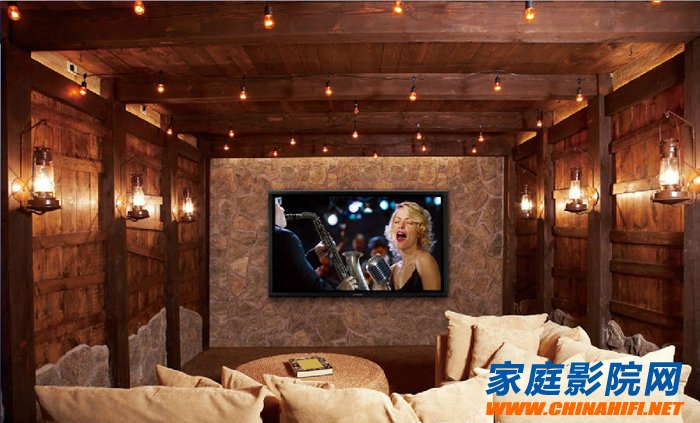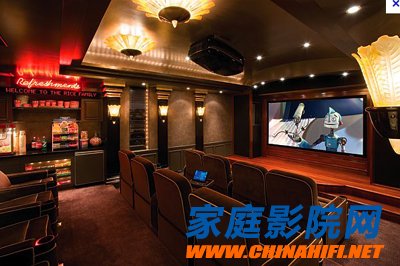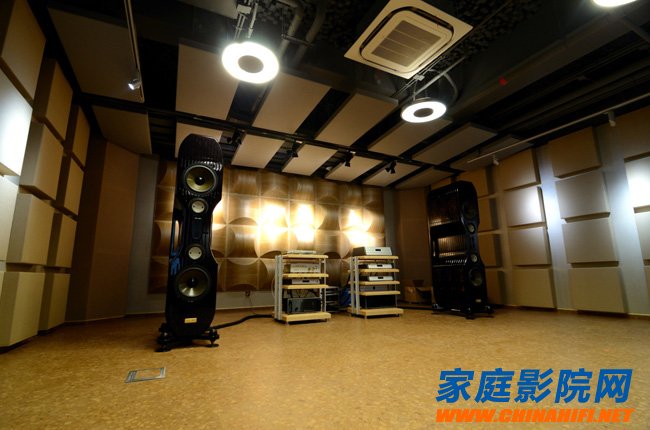The key to the success of the home theater network () speaker (horn) and amplifier (amplifier)? The key is of course more than one, but I think the most important one is whether the expansion machine can succeed. The low-frequency "moderate" of the horn is introduced, so that the sense of low-frequency is not too "too little" or "too much", just to produce a full sense of music balance. We will not talk about the "too much" part. This time we only talk about the "too little" part.
Usually, if the amplifier can't introduce enough low frequency, regardless of the detailed reasons, we will all agree that it is mismatched. Here, I have to give a description of the "low frequency" here. The so-called low frequency in this paper refers to the frequency from 40Hz to 160Hz, that is, the frequency between the low frequency (40Hz-80Hz) and the low frequency (80Hz-160Hz). So, if you want to be precise, I should write "low frequency and low frequency" right? However, as far as the average person is concerned, if the bass effect of a sound system is not good enough, people usually say that "low frequency" is not good, and Few people will say "low frequency" and "low frequency" are not good. In fact, the so-called low frequency is not good for the average person. It is said that the low frequency and the low frequency are not good.

Low frequency music is good or not
Perhaps you will be wondering, how do I miss the extremely low frequency between 20Hz and 40Hz? Actually, it is not that I missed it, but the lowest frequency of this section is not the normal speaker. It must be at least a large quality speaker or four pieces. The horn can be regenerated, even the general active subwoofer I think is not so easy to send out, so don't mention it. What's more, even if the speaker can be sent out, but the space is not big enough, what you hear will be a multiplier sound above 40Hz, not a really low 20Hz-40Hz sound.
In retrospect, what is the frequency between 40Hz and 160Hz? It is possible to control whether the sound is good or not. If you have studied it in depth, you will find that this frequency really has a great impact, and it is very important. Usually, what the average person thinks is that "the bass can't be pushed out", "no bass", "sound hard", "the sound has no elasticity, no Q degree", "sound '蹬' (the pronunciation of the Minnan dialect) does not come out", "the scale of the sound field Feeling is not big enough, "Piano low frequency extension is not good", "string music group has no thickness", "low frequency foundation is not strong enough", "orchestral momentum is not enough", "popular music is not enough impact", "foot drums" Negative results such as "sound thin" are caused by insufficient volume of this frequency. Conversely, if the sense of frequency at 40Hz-160Hz is just right in every space, the sound you hear will be so comfortable that you will not be tired of listening to music all day; not tired. It can be said that all sin and beauty are born because of the frequency of 40Hz-160Hz.
Different types of music have different needs for low frequency
Although this frequency is important, not all music types can highlight its importance. Among the many music types, the chamber music such as string quartet and piano trio does not have a high demand for the frequency of 40Hz-160Hz. Even if this frequency is insufficient, it will not have much influence on the integrity of the music. Therefore, the small speakers can perform quite well in chamber music such as string quartets or piano trios. Instead, the big horn will smash this light and powerful chamber music into a bloated space in a space with severe mid-low frequency standing waves.
However, piano solo is very much in need of 40Hz-160Hz frequency, especially in the piano's bass key size sense, authority and the nature of the downward extension is more indispensable. If this frequency is insufficient, the sense of scale of the piano will become smaller, the richness of the piano sound will not be enough, and the sound will become hard. However, in the case of piano accompaniment, since the music usually does not emphasize the highlight of the piano or the particularly low and strong scales, tracks such as violin sonatas or piano trios usually do not have a strong demand for the 40 Hz-160 Hz frequency.

The majestic drum sound is between 60Hz and 120Hz.
All pop music or jazz that pays attention to the drum rhythm is very demanding for the 40Hz-160Hz frequency, especially around 60Hz-120Hz. Why? Because the buzz from the drum in the drum is within this frequency. If the frequency of 60Hz-120Hz is insufficient, the pop music will sound thin, dry, and light, and there will be no full and solid sound. Don't talk about Punch impact at this time. In addition, if the frequency of popular music 40Hz-160Hz is insufficient, the scene will be reduced to a small size, the sound will not be soft, and the elasticity and Q degree will of course not be. At this point, you will hear a hard, unbearable sound.
What about vocals? Male and female voices are not very demanding for the frequency of 40Hz-160Hz, because the vocal frequency will be between 200Hz-1000Hz, which is why many small speakers can still have good voices. Therefore. However, because the small speaker has only a small size of the mid-woofer unit, it is responsible for the ultra-wide frequency domain frequency below about 3000 Hz, so it is impossible to regenerate the 40Hz-160Hz frequency enough.
Large orchestral demand for 40Hz-160Hz frequency is of course very strong. If this frequency is not enough, the orchestra you hear must be a thin sound, and the sense of scale is very small, and it is impossible to reproduce the magnificent momentum. In fact, if a pair of big speakers are placed in an inappropriate space, or if its own bass is difficult to extract, you will listen to the orchestral music just like a small speaker.

Why is the low frequency insufficient?
Ok, at this point you probably already know the importance of the frequency of 40Hz-160Hz in various music. Next, we want to study why the frequency is insufficient in the actual listening environment and equipment matching. The lack of low-frequency feeling can be divided into two reasons: “environmental factors†and “bad speakers and amplifiersâ€. Because environmental factors are easy to understand, it is usually because the listening material or the way of listening to the space causes too much low frequency to be absorbed, so that although the amplifier can push the low frequency of the speaker enough, after the absorption of the environment The amount of low frequency that is transmitted to the ear is still not enough.
The speaker and the amplifier are not well matched, the sound characteristics are not matched, the power is insufficient, the phase problem of capacitive reactance and inductive reactance, the damping factor is not high, the amplifier can't cope with the impedance curve of the speaker, and the bass unit has strong back electromotive force. Weaken the expansion of the machine thrust and so on. Regardless of the actual reasons, the lack of low-frequency sense always makes us feel the most unbearable. In the actual collocation example, we often find that although the speaker unit is not small, the efficiency is very high, and the power of the amplifier is large enough, but it sounds like a low-frequency sense is not enough. This case involves the medium-high frequency that I often say. The segment and the low frequency band are unbalanced.
I want to change the wire as a means to increase the sense of low frequency, and the effect is quite limited, and it is not the fundamental.
Effective way to solve the problem of low frequency
There are a set of methods for solving the problem of low-frequency sensation. Many people encounter this problem, either replacing the wire or replacing the amplifier, or even replacing the horn. According to my experience, although the replacement of the wire can slightly increase the sense of low frequency, the amount of low frequency added is extremely limited and cannot solve the problem fundamentally. While replacing the amplifier is more effective than changing the wire, it is not guaranteed to be successful. Why? Because the distribution of high, medium and low frequency sensitivities of different amplifiers does not vary greatly, unless the amplifier deliberately distort basic technical specifications and requirements. The big difference between the expansion machines is the control and thrust of the low frequency band. The expansion machine with strong control and thrust can of course reproduce more and better low frequencies, but usually it requires money to build. The worst thing is that despite the replacement of the more expensive amplifier, the low-frequency sense still does not improve, then you must consider whether the low-frequency sense of the speaker is absorbed by the space environment.
To be honest, the most fundamental way to make the best match between the amplifier and the speaker is to use active electronic crossover, which is why electronic recording is used in professional studios. If you visit the Abbey Road studio in London, you will find that the B&W801 is an electronic version. However, the cost of electronic crossover is high, and the active speaker will make the amplifier not play, so it has not been popular in the audio industry. In the past, I advocated "double-expansion therapy" because double-expansion therapy can solve the problem of insufficient thrust and control of the woofer. In fact, this is a compromise-like electronic-like method. However, even the "double-expansion therapy" may not fully compensate for the low frequency absorbed by the space, so in the previous issues I proposed "subwoofer therapy."
Genesis's four-piece speaker is like a floor-standing speaker that has been paired with a super bass. The user doesn't have to worry about how to match the subwoofer, just need to adjust it.

"Subwoofer therapy" is economically effective
“Subwoofer therapy†is a simpler, more economical, and more efficient way. What do you say? Because the current active subwoofer is highly selective, the price is quite economical compared to expensive amplifiers. It can provide the most low-frequency sense, which is enough to make up for the low-frequency sense absorbed by the space. More importantly, the active subwoofer's operating frequency band is just above the low frequency band (40Hz-160Hz) that we think is most important. So whether you're using a big horn or a small horn, as long as you feel the sounds have the shortcomings I mentioned at the beginning of this article, it's worth making up for it with the low-frequency feel of the active subwoofer.
For the low-frequency sense of the small speakers, many people can accept the fate, and can accept the lack of active low-bass to make up for the low frequency. However, for those who use large speakers and still feel that the low-frequency sense is insufficient, it is inevitable that they will use the subwoofer to compensate for the low-frequency sense. In fact, no matter how big the speaker is, the lack of low frequency is insufficient, and the low frequency is not good enough. At this point, even if your big horn is worth a million, it will become worthless. No, it brings you not happiness but pain every day. What is the use of a beautiful appearance? In fact, you don’t have to accept the fact that you need to add a subwoofer to the big speakers. Those four-piece big speakers don’t. Is it all the same? It is only at the factory to help you, and you are doing it yourself.
Both large and small speakers can add subwoofer
Basically, the small speaker and the big speaker are no different in adding the active subwoofer. The difference should only be the adjustment of the crossover point and the volume sense. In the end, what is the most appropriate point for the crossover point and the sense of volume? To be honest, this depends on the ear. If you don't have a lot of skill in sound adjustment, I suggest you adjust to the point where you sound comfortable. If you are an old-fashioned audio fan, you can of course make a comprehensive judgment according to the requirements of "Audio Twenty". In short, if you adjust improperly, you will feel that the low-frequency sense is still insufficient; or it is too bloated and unresponsive. Only when properly adjusted, will you feel the sound of softness, flexibility, speed, fastness, strong impact, and large sound field size. At this time, "the bass can not be pushed out", "no bass", "sound hard", "the sound has no elasticity, no Q degree", "sound '蹬" (the voice of the Minnan dialect) does not come out", "the sound field size is not big enough "Piano low frequency extension is not good", "string music group has no thickness", "low frequency foundation is not strong enough", "orchestral momentum is not strong enough", "popular music is not enough impact", "small drums are sizzling" The shortcomings should all disappear without a trace.
At this point, I think that although many people are already aware of the importance of 40Hz-160Hz, there is still doubt about "subwoofer therapy". Indeed, the speed response will not have a negative impact after adding a subwoofer? Where is the position of the subwoofer? Can the subwoofer be seamless with the frequency of the original speaker? How can the problem of phase inconsistency be found and solved? Will there be any problem with the tone connection? I can tell you clearly when I am here. When you have a low-frequency problem, music is definitely not good, because it has already distort the subtle balance that music should have. At this point you have spent a lot of money to get yourself into the heat. Compared to the pain of not enjoying the beauty of music, your doubts can be considered insignificant. Even if every doubt has a problem, it will not be satisfied with the satisfaction of adding a subwoofer.
Add a subwoofer to balance the sound range and enjoy the beauty of music.

She should be reviewed
Written here, I feel a lot of feelings, so I have been deeply impressed by audiophiles and audio fans for the pursuit of higher performance. I have neglected the basic requirements of listening to music. For example, the early expansion machine will be equipped with a treble and bass adjustment knob, in order to match the speaker and space, so that the amplifier can get the most balanced match with the speaker anyway. However, in order to obtain a more direct and transparent sound, the audio manufacturer removed all the extra side adjustments, leaving only the input switch and volume adjustment. That's right, although you can get a more transparent, more resolving sound, but the expansion machine and the speaker, the space is completely unmatched with the flexibility of adjustment, so that although the resolution of the sound, the sense of transparency is better, but the music It is getting harder and harder to hear.
In the 30 years from the 1970s to the present, the audio industry has almost done this kind of "staying at the end", and these "squatting" pursuits have made the audio fans pay more and more money, but the music enjoyment is only Disproportionate ascension, even worse. I think that the concept of adding "medium channel" and "subwoofer" in AV multi-channel is worth pondering. I even think that if a cheap multi-channel speaker combination can achieve the balance of music that can not be achieved by expensive two-channel, we would also reject the multi-channel Hi End is not enough? Can not express the expensive equipment of music balance requirements Just because of High Price, let's say it is Hi End? This is a question worth pondering. WeChat: cnhifi.
What is 5G CPE?
5G CPE is a kind of 5G terminal equipment. It takes 5G signals from a carrier's base station and converts them into WiFi or wired signals, allowing more local devices (phones, tablets, computers) to access the Internet. It can be seen that 5G CPE is similar to the function of the "optical network unit" for home fiber broadband access.
What is a WiFi router?
WiFi routers are also known as wireless routers or access points.
A WiFi router acts as a Wi-Fi transmitter. It connects directly to a modem, router or switch via cable. This allows it to receive information from the Internet and transmit information to the Internet. Phones, tablets, laptops and other devices can pick up its Wi-Fi signal and then connect to the Internet.
What is the difference between 5G CPE and WiFi router?
The 5G CPE is actually a combination of a 5G modem and a WiFi router. With an independent 5G CPE, the device can access the Internet directly through the WiFi signal or the LAN port of the CPE. Of course, the 5G SIM card needs to be inserted into the SIM card slot of the CPE. However, a WiFi router will not be able to provide Internet access without connecting to a modem or router via cable.
To provide users with greater flexibility and reliability, many 5G CPE routers not only support 5G networks and 4G LTE networks, but also come equipped with WAN Ethernet ports for surfing the Internet. For local networks, WiFi 6, WiFi 5, and LAN ports are usually supported. Some models, such as the Hocell 5G CPE M111, are also equipped with telephone ports for VoLTE/ VoNR voice services.
What are the advantages of 5G CPE over ONU?
ONU is a kind of CPE, and the difference between ONU and 5G CPE is that the former connects to optical fiber access network equipment, while 5G CPE connects to 5G base stations.
There is also a question, since there is an ONU, why do you still need 5G CPE, and will 5G CPE replace ONU?
Let's start with the conclusion, of course not.
The current 5G CPE products all use the same or similar 5G chips as 5G mobile phones, have strong 5G connectivity, support SA/NSA networking, and are compatible with 4G/5G signals. In terms of speed, 5G CPE is similar to ONU.
The advantages of 5G CPE
1. Mobility and
Unlike traditional ONUs, which can only be used in fixed locations, 5G CPE can be "mobile." Where there is a 5G signal, 5G CPE can be used.
For example, when we go on a family vacation to a suburban estate, we can use 5G CPE to set up a Wi-Fi 6 high-speed hotspot that allows all family members to go online and share videos on social networks.
Another example is when a company is away at a trade show, it can use 5G CPE to provide Internet access to visitors and employees.
Traditional "fibre broadband" is relatively easy to set up. You go to the sales office and request a package, and then you can open it. But cancelling is tricky. Today's broadband services have a contract period. Before the end of the agreement period, you can not arbitrarily stop it. If you need to move, you have to switch to fiber broadband, which is also very troublesome. As for 5G CPE, as long as you have a 5G mobile phone SIM card, you can get high-speed Internet access.
For young people who are renting, as well as small businesses that need Internet service, 5G CPE is an ideal choice because of its mobility, fast Internet service registration and termination. 5G CPE is also suitable for remote areas or places with difficult terrain where fiber is virtually unavailable. Due to its large area and small population, many parts of the world began to use CPE long ago. They use 5G Outdoor CPE to receive signals from base stations and convert them into raw signals to access the Internet.
5G CPE can be upgraded to small base stations
5G CPE modifies 4G or 5G as a WiFi hotspot. WIFI devices can be converted via 5G CPE to access 4G or 5G networks.
Further, the WIFI hotspot, including the information processing and transmission within the CPE, is divided into 2 completely separate channels. The internal network channel has its own wi-fi, which is supervised by a person, and also has an account password verification. The external network channel is regulated and managed by the carrier. Two-way verification, remote monitoring, encrypted transmission, vibrant passwords, strict isolation of software and some devices to meet carrier-grade security requirements, complete isolation of indoor and outdoor wi-fi, extrannetwork-channel authentication of customer SIM cards,
5G CPE can be upgraded to a small base station, with both WiFi LAN and micro-base station functions. Good signal at the window, negative signal inside the car. Install a 5G CPE micro-base station by the window of your home and connect it to a power supply (or bring your own power supply).
It can access 4G and 5G networks through the CPE's external network. The phone charges, SMS charges, and information charges generated by the CPE are included in the phone SIM card number, but are not included in the CPE device. Peripheral WIFI devices without SIM cards, computer tablets (generally with WIFI), without wi-fi can get the USB user interface wi-fi card, through the WIFI Intranet access to 4G/5G network, resulting in traffic charges Input number corresponding to the CPE SIM card.
5G CPE micro base station, no matter where you go, as long as there is a 4G/5G signal by the window, there are mobile phones indoors, there are other terminal tools with SIM cards, and WIFI, you can call the Internet standby to solve the problem of indoor invisible. WIFI tools without SIM cards can also pass through the Intranet.
5G CPE applications
1. 5G CPE will act as a smart home gateway
In addition to providing Internet access, 5G CPE will also act as a smart home gateway in the future.
The demand for home routers has been the focus of competition among many vendors, because the router itself brings profits, as it is the gateway to the entire home network service and the entry platform for digital home operations. The 5G CPE serves the same purpose as a router. It will be the intelligent gateway for the unborn 5G family and the fulcrum for the intelligent life of the whole family.
With 5G CPE, users can control a variety of smart devices in their homes and connect everything, significantly enhancing the life experience of family members.
5G CPE has great potential for enterprise demand
In addition to consumer demand, 5G CPE has a very broad operational prospect in terms of enterprise demand.
Take smart factories, for example. In the future, all the devices and gears in the factory will be networked. 5G CPE can act as a unified traffic inlet and outlet for all devices in an area (shop floor), providing low-cost, high-speed network connectivity for these devices.
With the increase of application scenarios, 5G CPE will support more communication protocols other than 5G (such as Bluetooth, UWB, etc.), and truly become the control center of all devices.
3. Pipe network monitoring
Urban heating monitoring, natural gas network wireless monitoring, urban water supply network monitoring.
conclusion
All in all, 5G CPE is very important for both households and businesses.
With the full rollout of 5G network construction, 5G signal coverage is getting farther and farther. The demand for 5G CPE will continue to increase, and there will be more and more application scenarios around 5G CPE.
5G Cpe,Wifi 6 Router,5G Wifi Router,5G Sim Card Router
Shenzhen MovingComm Technology Co., Ltd. , https://www.movingcommtech.com
